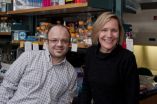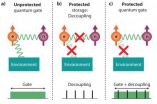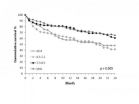(Press-News.org) HOUSTON -- (April 9, 2012) -- A new study by Rice University scientists reveals that plants can use the sense of touch to fight off fungal infections and insects. The study, which will be published in the April 24 issue of Current Biology, finds that plant defenses are enhanced when plants are touched.
"From previous studies, we knew that plants change their growth in response to touch but we didn't know how these growth changes were activated," said Wassim Chehab, a faculty fellow in Rice's Department of Biochemistry and Cell Biology and lead author of the new study. "We used a widely studied plant, Arabidopsis thaliana, to test the idea that the touch-induced growth was regulated by a plant hormone called jasmonate."
Jasmonate plays a critical role in initiating plant defenses against plant-eating insects. When jasmonate levels go up, the plant increases production of metabolites that give herbivores an upset stomach. Jasmonate defenses, which also protect against some fungal infections, are employed by virtually all plants, including tomatoes, rice and corn. The new study provides the first evidence that these defenses are triggered when plants are touched. In the study, students touched the plants in a laboratory, but the researchers say the touch-induced response could also be activated by animals, including insects, and wind.
"Plants can't move, so it makes sense for them to have a highly developed sense of touch to react quickly to changes in their environment," said study co-author Janet Braam, professor and chair of Rice's Department of Biochemistry and Cell Biology.
The famed Venus flytrap uses its sense of touch to rapidly close and trap insects. But in prior research at Rice, Braam and her colleagues showed that Arabidopsis was also extremely responsive to touch. In 2000, her lab used tools of biotechnology to produce a plant that glowed with light wherever it was touched. They also showed that Arabidopsis plants that were touched regularly grew much shorter and slower -- much like trees exposed to a windy coastline will grow short and bent.
"In this new work, we show that jasmonate mediates this growth response in Arabidopsis," Braam said. "Our experiments show that plants that are repeatedly touched maintain high levels of jasmonate and therefore have enhanced insect and fungal tolerance. In addition, we found that eliminating key genes required for jasmonate production results in the inability of plants to grow shorter and slower when touched."
Braam and Chehab also found that plants that were touched often, and consequently had high levels of jasmonate, were more resistant to fungal and insect attacks.
Chehab said plants do not base their production of jasmonate on a single source of information.
"There are multiple signals that can influence the jasmonate response," Chehab said. "Touch is one, but we also recently found that this response can be mediated by the plant's internal clock, or circadian rhythm. It's a complicated picture, but by piecing it together, we get a clearer understanding of plant pest resistance."
INFORMATION:
The research was supported by the National Science Foundation. Additional co-authors include undergraduates Chen Yao and Zachary Henderson, and postdoctoral research associate Se Kim, all of Rice.
High-resolution images are available for download at:
http://news.rice.edu/wp-content/uploads/2012/02/0217_braam-b.jpg
CAPTION: Rice University biologists found that plant defenses against leaf-eating herbivores, like this cabbage looper caterpillar, are activated by the plant's sense of touch.
CREDIT: Tommy LaVergne/Rice University
http://news.rice.edu/wp-content/uploads/2012/03/TOUCH_Press_Fig-large.jpg
CAPTION: Plant growth is affected by touch. Arabidopsis plants that were touched several times each day (right) grew shorter stems than those that were untouched (left). Rice University biologists found that this growth response is controlled by a plant hormone that protects plants from insects and fungal infections.
CREDIT: Wassim Chehab/Rice University
http://news.rice.edu/wp-content/uploads/2012/03/0306_BRAAM.jpg
CAPTION: From left, Rice University biologists Wassim Chehab and Janet Braam found a link between the touch-induced plant growth changes and plant defenses against insects and fungal infections.
CREDIT: Jeff Fitlow/Rice University
Located on a 300-acre forested campus in Houston, Rice University is consistently ranked among the nation's top 20 universities by U.S. News & World Report. Rice has highly respected schools of Architecture, Business, Continuing Studies, Engineering, Humanities, Music, Natural Sciences and Social Sciences and is known for its "unconventional wisdom." With 3,708 undergraduates and 2,374 graduate students, Rice's undergraduate student-to-faculty ratio is 6-to-1. Its residential college system builds close-knit communities and lifelong friendships, just one reason why Rice has been ranked No. 1 for best quality of life multiple times by the Princeton Review and No. 4 for "best value" among private universities by Kiplinger's Personal Finance. To read "What they're saying about Rice," go to www.rice.edu/nationalmedia/Rice.pdf.
A bit touchy: Plants' insect defenses activated by touch
Rice University study links touch-activated genes to both growth and insect defense
2012-04-10
ELSE PRESS RELEASES FROM THIS DATE:
Opening the gate to robust quantum computing
2012-04-10
AMES, Iowa -- Scientists have overcome a major hurdle facing quantum computing: how to protect quantum information from degradation by the environment while simultaneously performing computation in a solid-state quantum system. The research was reported in the April 5 issue of Nature.
A group led by U.S. Department of Energy's Ames Laboratory physicist Viatsheslav Dobrovitski and including scientists at Delft University of Technology; the University of California, Santa Barbara; and University of Southern California, made this big step forward on the path to using the ...
O'Reilly Collins Wins $4.6 Million Verdict in Insurance Bad Faith Case
2012-04-10
On March 28, 2012, O'Reilly Collins obtained a verdict in favor of its client, Stephens & Stephens XII, LLC, and against Fireman's Fund Insurance Company for $4,673,125.10 for failure to pay an insurance claim.
Stephens' warehouse was stripped of copper wiring, causing over $2 million electrical and mechanical damages. Stephens was notified of the theft on July 1, 2007 by the Richmond police who apprehended two thieves. Stephens promptly notified its insurance company, Fireman's Fund, of the loss and asked to pay for the repairs. Fireman's Fund initially promised ...
Life expectancy may affect when you get married, divorced, have kids: Queen's University study
2012-04-10
Major life decisions such as marriage, divorce, abortion, having a child and attending university may be subconsciously influenced by how long people believe they will live, according to a Queen's University study.
"Life expectancy might be driving all of these major decisions," says Daniel Krupp, a post doctoral fellow in the Queen's math department who has a background in psychology and biology.
The longer someone expects to live, the more time they will invest in education. If life expectancy is short, someone may decide to get married and have children sooner, or ...
Caution needed when curbing overuse of healthcare resources, study suggests
2012-04-10
NEW YORK, April 9, 2012 – In the current hyper-charged United States healthcare debate, the focus on lowering cost without compromising quality of care remains a priority. But according to a new study by researchers at NYU Langone Medical Center and colleagues, one common approach may have serious unintended consequences.
Funded by the Robert Wood Johnson Foundation's (RWJF) Clinical Scholars program and the United States Department of Veterans Affairs (VA), the study, which appears today in the April issue of Health Affairs, examines the potential impact of policies ...
Heart failure patients with diabetes may benefit from higher glucose levels
2012-04-10
Lowering glucose levels for people with diabetes is normally critical to improving health outcomes. But for those with heart failure, that might not always be the case, say UCLA researchers.
A new study found that for advanced heart failure patients with diabetes, having higher blood glucose levels may actually help improve survival rates.
Currently published online in the American Journal of Cardiology, UCLA researchers compared levels of a marker used to track glucose levels called glycosylated hemoglobin in advanced heart failure patients with and without diabetes. ...
New Jersey Attorney Hanan M. Isaacs Featured Speaker for West LegalEdcenter CLE: E-Discovery and Evidence in the Era of Social Media
2012-04-10
Techniques for leveraging e-discovery and social media evidence. The West LegalEdcenter webinar will include discussions on the importance of e-discovery and social media evidence and how to use it as leverage in civil and criminal litigation. Mr. Isaacs, a New Jersey attorney, mediator, and arbitrator, will provide techniques for obtaining e-discovery and uses for social media. He will also cover material on the recent privacy invasion and bullying issues that resulted in the Rutgers University student's criminal trial and guilty verdicts.
Hanan M. lsaacs, M.A., J.D., ...
Job injuries among youth prompt calls for better safety standards
2012-04-10
AURORA, Colo. (April 9, 2012) – Dozens of American youth under the age of 20 die on the job each year while thousands more are injured, often due to poorly regulated work environments, according to a new report released by the Colorado School of Public Health.
"We don't tend to think of child labor as a major issue in the U.S. but we should," said the study's lead author Carol Runyan, Ph.D., MPH, and professor of epidemiology at the Colorado School of Public Health. "Laws governing the employment of youth ages 14 to 17 in this country are often very lenient and in the ...
TravelShark(TM) Honors 30 Unique Travel Discoveries with New Breed of Travel Award
2012-04-10
TravelShark today unveiled the first 30 winners of the Sharky Awards, a hyper-local awards program designed to recognize the freshest, most inspiring travel experiences across the globe.
The first group of winners is divided into three categories: People, Places, and Things. TravelShark launched the Sharky Awards in late 2011 and named this class of honorees as its first quarterly collection of rare discoveries and unique finds that make memorable additions to people's travel itineraries.
TravelShark singled out the water slide at Golden Nugget Las Vegas for top ...
Loss of predators in Northern Hemisphere affecting ecosystem health
2012-04-10
CORVALLIS, Ore. – A survey done on the loss in the Northern Hemisphere of large predators, particularly wolves, concludes that current populations of moose, deer, and other large herbivores far exceed their historic levels and are contributing to disrupted ecosystems.
The research, published today by scientists from Oregon State University, examined 42 studies done over the past 50 years.
It found that the loss of major predators in forest ecosystems has allowed game animal populations to greatly increase, crippling the growth of young trees and reducing biodiversity. ...
Corneal thickness linked to early stage Fuchs' Endothelial Corneal Dystrophy
2012-04-10
A national consortium of researchers has published new findings that could change the standard of practice for those treating Fuchs' Endothelial Corneal Dystrophy (FECD), a disease characterized by cornea swelling that can eventually lead to the need for corneal transplantation. The Fuchs' Endothelial Corneal Dystrophy Genetics Multi-Center Study Group, led by co-principal investigators Jonathan Lass, MD, Charles I Thomas Professor and chair, Case Western Reserve University Department of Ophthalmology and Visual Sciences and director, University Hospitals Eye Institute, ...
LAST 30 PRESS RELEASES:
Survey reveals ethical gaps slowing AI adoption in pediatric surgery
Stimulant ADHD medications work differently than thought
AI overestimates how smart people are, according to HSE economists
HSE researchers create genome-wide map of quadruplexes
Scientists boost cell "powerhouses" to burn more calories
Automatic label checking: The missing step in making reliable medical AI
Low daily alcohol intake linked to 50% heightened mouth cancer risk in India
American Meteorological Society announces Rick Spinrad as 2026 President-Elect
Biomass-based carbon capture spotlighted in newly released global climate webinar recording
Illuminating invisible nano pollutants: advanced bioimaging tracks the full journey of emerging nanoscale contaminants in living systems
How does age affect recovery from spinal cord injury?
Novel AI tool offers prognosis for patients with head and neck cancer
Fathers’ microplastic exposure tied to their children’s metabolic problems
Research validates laboratory model for studying high-grade serous ovarian cancer
SIR 2026 delivers transformative breakthroughs in minimally invasive medicine to improve patient care
Stem Cell Reports most downloaded papers of 2025 highlight the breadth and impact of stem cell research
Oxford-led study estimates NHS spends around 3% of its primary and secondary care budget on the health impacts of heat and cold in England
A researcher’s long quest leads to a smart composite breakthrough
Urban wild bees act as “microbial sensors” of city health.
New study finds where you live affects recovery after a hip fracture
Forecasting the impact of fully automated vehicle adoption on US road traffic injuries
Alcohol-related hospitalizations from 2016 to 2022
Semaglutide and hospitalizations in patients with obesity and established cardiovascular disease
Researchers ‘listen in’ to embryo-mother interactions during implantation using a culture system replicating the womb lining
How changing your diet could help save the world
How to make AI truly scalable and reliable for real-time traffic assignment?
Beyond fragmented markets: A new framework for efficient and stable ride-pooling
Can shape priors make road perception more reliable for autonomous driving?
AI tracks nearly 100 years of aging research, revealing key trends and gaps
Innovative techniques enable Italy’s first imaging of individual trapped atoms
[Press-News.org] A bit touchy: Plants' insect defenses activated by touchRice University study links touch-activated genes to both growth and insect defense



